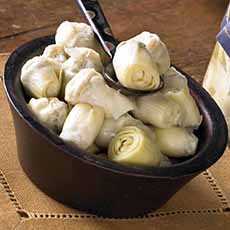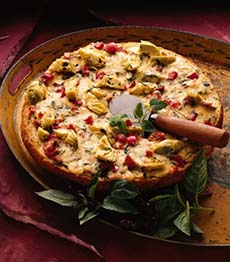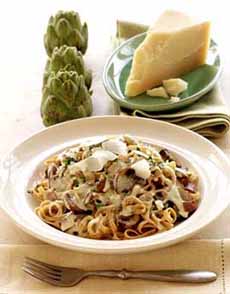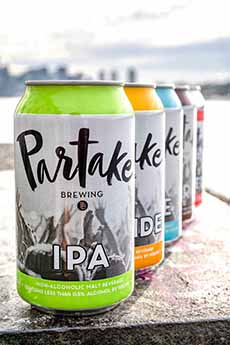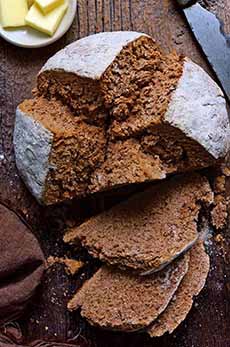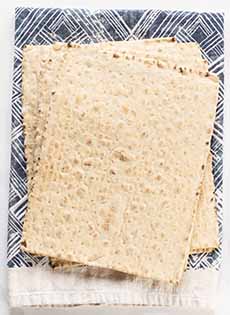|
March 16th is National Artichoke Day.
We love artichokes; both steamed whole artichokes and the hearts themselves, purchased in cans or jars.
If you go to a club store, you can often find a good deal on a large jar of artichoke hearts. When we land a few jars, we go to town with different preparations.
Mini Tip: If you can, buy artichoke hearts that are not marinated (photo #1). Brands vary widely in the quality of the oil and the amount of salt. We’ve bought jars in oversalted marinades that could only be enjoyed by the more-salt-is-better crowd.
So, we’d rather use our own good oil, and salt and seasonings to taste.
A large number of recipes with artichoke hearts involve dips and salads.
For National Artichoke Day, we offer you these 24 other ideas.
1. ARTICHOKE HEARTS AT BREAKFAST
Artichoke Omelet: Beat the eggs and and season with salt and pepper. As the omelet sets, fill with chopped artichoke hearts and your choice of extras: capers, cheese, herbs and/or mushrooms.
On The Side: Marinated artichokes make a tasty counterpoint to boiled, fried and poached eggs.
2. ARTICHOKE HEARTS AT LUNCH
Artichoke Galette or Quiche: Here’s a recipe.
Artichoke Grains Bowls: Add plain or marinated artichoke hearts with your other grain bowl favorites.
Artichoke Soup: Heat 1 quart of chicken stock and use an immersion blender (or a stand blender) to blend with 2 cups of chopped artichoke hearts. Add an optional dash of cream, and season with salt and pepper.
Artichoke Pizza: Top your pie with artichoke hearts (plain, not marinated; halved or quartered) and anything else you like, from other veggies to prosciutto (photo #2).
Artichoke & Tuna Salad: Blend 1 can tuna (drained), 1/2 cup finely chopped artichoke hearts, 1/4 cup finely chopped sundried tomatoes, 1/2 teaspoon salt, 1 tablespoon lemon juice, and 1 tablespoon olive oil. Serve on a green salad or a sandwich.
Greek Yogurt & Artichokes: Place the artichoke hearts in a food processor, along with thyme or other herb(s) of choice. Add a bit of lemon zest and pulse to your desired consistency. Blend with plain Greek yogurt to taste. (This can also be a tasty spread on crostini/toasts, or used as a sauce on fish or poultry.)
3. ARTICHOKE HEARTS IN APPETIZERS & SNACKS
Antipasto: Combine marinated artichoke hearts on a platter with bocconcini (mozzarella balls, marinated), olives, pepperoni, prosciutto, provolone and salami.
Artichoke Salsa: Version #1: Combine 1 cup finely chopped artichoke hearts, 1 or 2 large chopped tomatoes, 1/2 chopped red onion, 1 diced jalapeño and 1 minced garlic clove. Season with salt to taste. Version #2: Start with a jar of plain salsa, red or green. Add the chopped artichoke hearts and, if desired, garlic.
Artichoke Crostini: Mix 1 cup softened cream cheese, goat cheese or ricotta with 1/2 cup chopped artichoke hearts and some lemon zest. Serve with a plate of plain crostini (toasts), or pre-spread them.
Artichoke Deviled Eggs: Halve 6 hard-boiled eggs and blend the yolks with 1/2 cup Greek yogurt or mayonnaise, 1 tablespoon Dijon mustard, 1/4 teaspoon salt (more to taste), and 1 pinch cayenne pepper. Spoon the mixture back into the egg whites and top with a snip of chive or parsley.
Artichoke Dip: Thoroughly blend 1 cup sour cream with 1/2 cup finely chopped artichokes, 1/2 cup steamed spinach, 1 teaspoon salt, and 1 tablespoon olive oil.
Artichoke Guacamole: Add 1 cup finely cup chopped artichoke hearts with 1 cup guacamole. Season with salt or pepper (or chile flakes).
Artichoke Hummus: Add to a food processor, 1 can rinsed and drained chickpeas, 1 cup artichoke hearts, 1 teaspoon salt, 1 tablespoon tahini, 1 tablespoon olive oil, and the juice of 1 lemon. Process to desired consistency.
Artichoke Snack Skewers: Cut artichoke hearts in half (or what best fits on the skewers) and pair with cherry or grape tomatoes, mozzarella balls (bocconcini), and anything else you like.
4. ARTICHOKE HEARTS IN MAIN COURSES
Artichoke Crab Cakes: Preheat the oven to 350°F. Combine 1 pound crab meat, 1 cup chopped artichoke hearts, 1/2 cup mayonnaise, 1 teaspoon salt and 1 teaspoon Old Bay seasoning. Form the mixture into balls and place on a sprayed baking sheet. Bake 12 to 15 minutes until slightly browned and cooked through. Makes 4 servings.
Artichoke Pasta: Cook 1 pound pasta of choice until al dente. Toss with 1 cup warmed chopped artichoke hearts, 1/2 cup freshly-grated parmesan cheese and 1 tablespoon olive oil. Add shredded basil or herbs of choice. Serve with a pepper mill for freshly-ground pepper (photo #3).
Artichoke-Stuffed Chicken Breasts: Preheat the oven to 350°F. Butterfly 2 chicken breasts. Blend in a food processor 1 cup of finely chopped artichoke hearts, 1 teaspoon olive oil, 1 teaspoon or more of chopped herbs (basil, parsley, rosemary, thyme) and salt to taste. Spread the mixture on one side of each breast and fold over. Cook for 35 minutes or until the internal temperature reaches 165°F.
Skewers With Artichokes: Alternate artichoke hearts (whole or halved) with proteins and/or other veggies. Grill.
5. ARTICHOKE HEART SIDES
Artichoke Gratin: Preheat the oven to 400°F. Place plain (not marinated) artichoke hearts in a baking dish. Top with sliced gruyère cheese and breadcrumbs. Bake until the cheese is melted and the artichokes are warmed through.
Fried Artichoke Hearts: Delicious as a side or an appetizer, with aïoli (garlic mayonnaise). Here’s a recipe.
Artichoke Potatoes: Version #1, stuffed baked potato (photo #5). Version #2: Add artichoke hearts to a pan of roasting potatoes. Version #3: Dice the artichoke hearts and blend into mashed potatoes.
Grilled or Roasted Artichoke Hearts: Brush plain (non-marinated) artichoke hearts with olive oil along with any other vegetables you want to grill or roast. Season with salt, pepper and herbs of choice. Roast for 30–35 minutes at 425°F.
|
